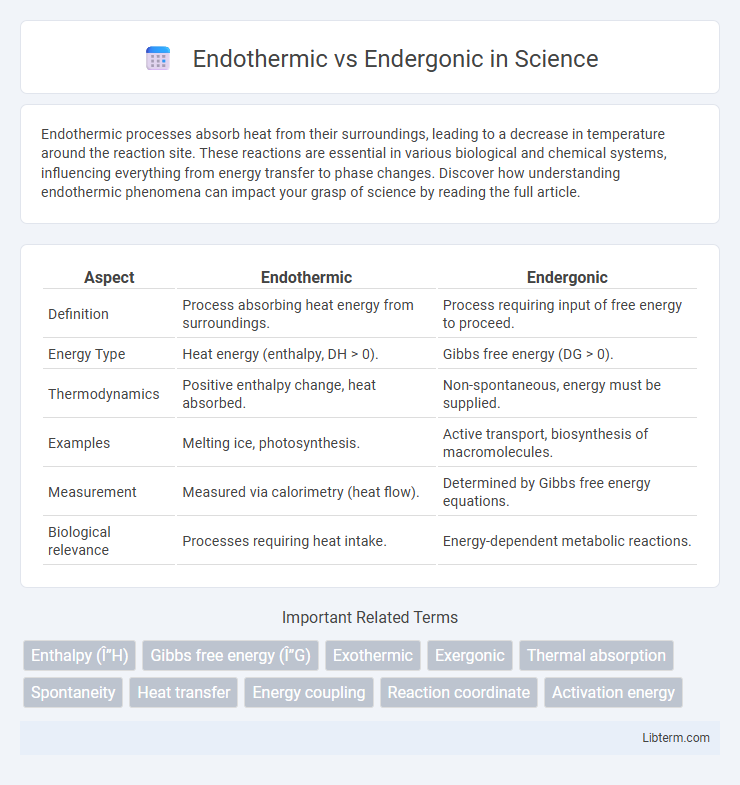Endothermic processes absorb heat from their surroundings, leading to a decrease in temperature around the reaction site. These reactions are essential in various biological and chemical systems, influencing everything from energy transfer to phase changes. Discover how understanding endothermic phenomena can impact your grasp of science by reading the full article.
Table of Comparison
| Aspect | Endothermic | Endergonic |
|---|---|---|
| Definition | Process absorbing heat energy from surroundings. | Process requiring input of free energy to proceed. |
| Energy Type | Heat energy (enthalpy, DH > 0). | Gibbs free energy (DG > 0). |
| Thermodynamics | Positive enthalpy change, heat absorbed. | Non-spontaneous, energy must be supplied. |
| Examples | Melting ice, photosynthesis. | Active transport, biosynthesis of macromolecules. |
| Measurement | Measured via calorimetry (heat flow). | Determined by Gibbs free energy equations. |
| Biological relevance | Processes requiring heat intake. | Energy-dependent metabolic reactions. |
Introduction to Endothermic and Endergonic Processes
Endothermic processes absorb heat energy from their surroundings, causing a decrease in ambient temperature, and are characterized by a positive enthalpy change (DH > 0). Endergonic processes require an input of energy to proceed, marked by a positive Gibbs free energy change (DG > 0), indicating non-spontaneity under standard conditions. Understanding the distinction between enthalpy-driven and free energy-driven reactions is essential for analyzing thermodynamic behavior in chemical and biological systems.
Defining Endothermic Reactions
Endothermic reactions absorb heat energy from their surroundings, causing a temperature decrease in the environment. These reactions require continuous energy input to proceed because the enthalpy change (DH) is positive, indicating energy absorption. Common examples include photosynthesis and the melting of ice, where energy intake drives chemical changes.
Understanding Endergonic Reactions
Endergonic reactions are chemical processes that require an input of energy to proceed, characterized by a positive Gibbs free energy change (DG > 0), indicating non-spontaneity under standard conditions. These reactions often involve the synthesis of complex molecules from simpler ones, such as in photosynthesis or ATP formation, necessitating continuous energy supply. Understanding endergonic reactions is crucial for studying metabolic pathways and energy transfer in biological systems, where coupling with exergonic reactions drives these processes forward.
Key Differences Between Endothermic and Endergonic
Endothermic reactions absorb heat from the surroundings, resulting in a positive change in enthalpy (DH > 0), while endergonic reactions require an input of free energy, indicated by a positive change in Gibbs free energy (DG > 0). Endothermic processes are primarily concerned with heat energy transfer, whereas endergonic processes focus on the overall energy change and spontaneity of the reaction. The key difference lies in thermodynamics: endothermic reactions measure heat flow, and endergonic reactions measure total energy change, including enthalpy and entropy contributions.
Energy Transfer in Endothermic Versus Endergonic Reactions
Endothermic reactions absorb heat energy from the surroundings, causing a temperature decrease, while endergonic reactions require an input of free energy to proceed and are non-spontaneous under standard conditions. The key difference lies in energy transfer: endothermic processes specifically involve thermal energy changes, whereas endergonic reactions involve changes in Gibbs free energy (G > 0). Understanding these distinctions is critical for studying metabolic pathways, where endergonic reactions are often coupled with exergonic reactions to drive energy transfer within cells.
Examples of Endothermic Reactions
Endothermic reactions absorb heat from their surroundings, commonly seen in processes like photosynthesis, where plants convert carbon dioxide and water into glucose using sunlight energy. Another example is the melting of ice, which requires energy input to break molecular bonds, transitioning from solid to liquid. Thermal decomposition reactions, such as the breakdown of calcium carbonate into calcium oxide and carbon dioxide, also demonstrate endothermic behavior by consuming heat to proceed.
Examples of Endergonic Reactions
Photosynthesis is a prime example of an endergonic reaction, where sunlight energy is absorbed to convert carbon dioxide and water into glucose and oxygen. Another common example is the synthesis of ATP from ADP and inorganic phosphate, a process that requires an input of energy from cellular respiration or photosynthesis. Protein synthesis also exemplifies endergonic reactions, as the formation of peptide bonds consumes energy sourced from ATP hydrolysis.
Importance in Chemical and Biological Systems
Endothermic reactions absorb heat energy, playing a crucial role in processes like photosynthesis and cellular respiration where energy input is essential for synthesizing complex molecules. Endergonic reactions require free energy, driving metabolic pathways that maintain life by converting energy into usable forms such as ATP. Understanding these distinctions is vital for manipulating biochemical reactions and designing efficient energy cycles in both natural and industrial applications.
Real-World Applications and Implications
Endothermic processes absorb heat, playing a critical role in applications such as refrigeration, where energy intake lowers temperatures to preserve food and pharmaceuticals. Endergonic reactions require energy input to proceed, essential in biochemical systems like photosynthesis, where solar energy drives glucose synthesis fundamental to life. Understanding these processes enables advancements in energy storage, synthetic biology, and climate control technologies.
Summary: Choosing Endothermic or Endergonic
Endothermic processes involve the absorption of heat, affecting the system's thermal energy, while endergonic reactions require an input of free energy to proceed. Selecting endothermic or endergonic depends on whether the focus is on thermal energy changes or Gibbs free energy changes in biochemical or chemical systems. Understanding the distinction is crucial for accurately describing energy dynamics in thermodynamics and metabolic pathways.
Endothermic Infographic

 libterm.com
libterm.com